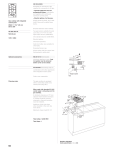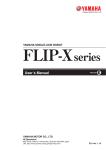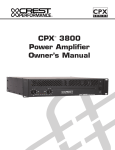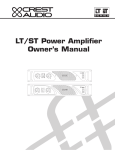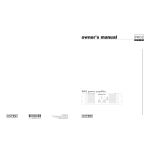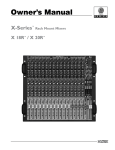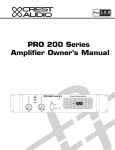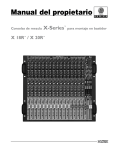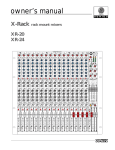Download Crest Audio PRO Series Owner`s manual
Transcript
CPX owner’s manual S E R I E S CPX power amplifier 20 20 23 26 16 6 29 (dB) 32 A PWR SIG B GCLTM GCLTM SIG CPX 900 CPX 1500 CPX 2600 23 6 PWR ON 26 16 29 (dB) 32 CPX 2600 POWER AMPLIFIER POWER important precautions 1 Save the carton and packing materials! Should you ever need to ship the unit, use only the original factory packing. Do not run the output of any amplifier channel back into another channel’s input. For replacement packaging, call Crest Audio’s Customer Service Department directly. Do not parallel- or series-connect an amplifier output with any other amplifier output. 2 Read all documentation before operating your equipment. Retain all documentation for future reference. Crest Audio is not responsible for damage to loudspeakers for any reason. 3 Follow all instructions printed on unit chassis for proper operation. 4 5 6 7 8 Never hold a power switch or circuit breaker in the on-position, if it won’t stay there by itself! Do not use the unit if the electrical power cord is frayed or broken. The power supply cords should be routed so that they are not likely to be walked on or pinched by items placed upon or against them. Always operate the unit with the AC ground wire connected to the electrical system ground. Precautions should be taken so that the means of grounding of a piece of equipment is not defeated. Damage caused by connection to improper AC voltage is not covered by any warranty. Mains voltage must be correct and the same as that printed on the rear of the unit. Do not ground any hot (red) terminal. Never connect a hot (red) output to ground or to another hot (red) output! 9 Power down and disconnect units from mains voltage before making connections. 10 Do not drive the inputs with a signal level greater than that required to enable equipment to reach full output. Do not connect the inputs or outputs of amplifiers to any other voltage source: such as a battery, mains source, or power supply, regardless of whether the amplifier is turned on or off. Connecting amplifier outputs to oscilloscopes or other test equipment while the amplifier is in bridged mono mode may damage both the amplifier and test equipment! Service Information Do not remove the cover! Removing the cover will expose you to potentially dangerous voltages. There are no user serviceable parts inside. Equipment should be serviced by qualified service personnel when: A. The power supply cord or the plug has been damaged. B. The equipment has been exposed to rain. C. The equipment does not appear to operate normally, or exhibits a marked change in performance. D. The equipment has been dropped, or the enclosure damaged. To obtain service: contact your nearest Crest Audio Service Center, Distributor, Dealer, or Crest Audio at 201.909.8700 USA Do not spill water or other liquids into or on the unit, or operate the unit while standing in liquid. Do not block fan intake or exhaust ports. Do not operate equipment on a surface or in an environment which may impede the normal flow of air around the unit: such as a bed, rug, weathersheet, carpet, or completely enclosed rack. If the unit is used in an extremely dusty or smoky environment: the unit should be periodically “blown free” of foreign matter. Do not use the unit near stoves, heat registers, radiators, or other heat producing devices. The power cord of equipment should be unplugged from the outlet when left unused for a long period of time. or visit www.crestaudio.com for additional information. email: [email protected] CPX Owner’s manual 1 2 installation 3 features overview 4 introduction p.3 p.5 unpacking mounting cooling and ventilation powering maintenance p.11 front panel rear panel contents application details p.23 installations bridged GCL 5 connections 6 Specifications p.31 wire gauge charts p.27 input output p.32, 33 p. 1 1 p. 2 introduction CPX owner’s manual introduction 1 welcome Congratulations on your purchase of a new CPX Series power amplifier, and thank you for your confidence in Crest Audio products. You are among the growing number of audio professionals who have made Crest Audio one of the world’s leading suppliers of professional and commercial/industrial audio systems. For your safety, please read the Important Precautions section before installing and operating the amplifier. The Crest Audio CPX Series amplifiers are designed for high operating efficiency and accurate sonic performance across the full audio bandwidth, even under stressful conditions. CPX series amplifiers feature a 2-way crossover and sub-sonic (low-cut) filter for each channel. Crossover frequencies are fixed at 150 Hz, allowing subwoofers to be driven at extremely high sound pressure levels, and the filters cut at 40 Hz to prevent low-end rumble. Using proven technology gained through years of amplifier design, this unit takes advantage of rugged TO-3P output devices mounted on massive aluminum extrusions and dissipates heat via an extremely quiet and effective 2-speed fan. CPX amplifiers employ mammoth toroidal power transformers and offer impressive specifications and features not found on similarly priced competitive units. These amps are designed to drive a 2-ohm load per channel, thus achieving awesome performance levels into 4 ohms in BRIDGE mode. CPX amplifiers are ruggedly constructed, rack-mountable pieces of gear with superb patching capability, allowing superior flexibility in application. Front panel features include calibrated, detented gain (dB) controls and LED indicators for power (PWR), signal presence (SIG), and GCL (Gain Comparator Limiter) activation on each channel, as well as a rocker mains POWER switch. The back panel contains an IEC connector for the mains power cord, a mains circuit breaker with reset, and the critical cooling fan opening. This opening should have an adequate supply of cool air and should never be blocked or restricted. Also on the back panel are the input and output sections, including an input barrier strip for permanent installations. Each channel input section includes a combo XLR / ¼" phone jack connector, THRU/LOW out and HIGH out ¼" jacks, and activation switches for the LOW CUT filter and crossover (150 Hz XOVER). Channel output sections feature dual shock-proof binding posts and 4-conductor Speakon connectors. An additional 4-conductor Speakon connector allows BRIDGE mode output. p. 3 2 p. 4 installation CPX owner’s manual installation what to do with the shipping carton 2 unpacking proper rack-mounting technique keeping the amplifier cooled mounting routine maintenance practices cooling and ventilation maintenance p. 5 2 installation CPX owner’s manual unpacking Please inspect the amplifier carefully immediately after unpacking. If you find any damage, notify your supplier/dealer immediately. Only the shipper may file a damage claim with the carrier for damage incurred during shipping. Be sure to save the carton and all packing materials for the carrier’s inspection. If the packing materials are in good condition, please save them. If you ever need to ship the unit anywhere without mounting it in a rack, you should take advantage of the original factory packing materials in order to avoid unnecessary damage. For replacement packaging, call Crest Audio’s Customer Service Department directly. see—service and support p. 6 installation 2 mounting All CPX Series amplifiers mount in standard 19-inch racks and occupy two rack spaces. Use of rear supports is highly recommended in all mobile and touring sound systems. CPX Front panel front height 3.47" / 88 mm 20 20 23 26 16 6 29 (dB) 32 A PWR SIG B GCLTM GCLTM SIG 23 ON 26 16 6 29 PWR (dB) CPX 2600 32 POWER AMPLIFIER POWER front width 19" / 483mm CPX rear panel rear width 17" / 432mm CAUTION CHANNEL A INPUT CHANNEL A BRIDGE LOW CUT TO REDUCE THE RISK OF FIRE OR ELECTRIC SHOCK DO NOT EXPOSE THIS EQUIPMENT TO RAIN OR MOISTURE. AVIS: RISQUE DE CHOC ELECTRIQUE-NE PAS OUVRIR. 150 Hz X OVER + + - CHANNEL B OUTPUT - MOUNT IN RACK ONLY - INSTALLER SUR SUPPORT DE MONTAGE SEULEMENT GCL TM OUT ENABLE / IN DEFEAT CHANNEL A A LOW CUT BAL. LOW Z GND HIGH Z 150 Hz X OVER B - BRIDGE THRU HIGH OUT LOW OUT + BRIDGE OUT STEREO/ IN BRIDGE - 15 A M P CHANNEL B WARNING: + front height 3.47" / 88mm BREAKER CHANNEL B INPUT CPX side view depth16" p. 7 2 installation CPX owner’s manual INSTALLATION CPX professional power amplifiers are designed for durability in commercial installations and provide the quality performance required in studio and home applications. They are 2-rack-space units of 16" (406 mm) depth designed to mount in a standard 19" rack. Rear mounting ears are provided for additional support. The minimum rack depth required from the mounting surface is 17" (432 mm) to allow adequate connector clearance. cooling and ventilation CPX amplifiers use a forced air cooling system to maintain a low, even operating temperature. Air is drawn in by a DC fan on the rear panel, flows through the cooling fins and then exhausts through the front panel vent. Heatsink temperature is monitored and controls the variable speed fan. Fan speed increases only as required, keeping fan noise to a minimum. If the heatsink surpasses it’s maximum allowed temperature, the thermal protection circuit will activate and open the output relays allowing the amplifier to cool to a safe temperature. Thermal protect activation only occurs under extreme thermal conditions and is not part of normal operation. p. 8 Make certain that there is enough space around the front and rear of the amplifier to allow the heated air to escape. When mounting in a rack, try to avoid using doors or covers on the front and rear of the enclosure; the exhaust air must not be impeded suggestion In racks with closed backs allow at least one standard-rackspace opening for every four amps. installation 2 Basic setup Rack mount the amplifier in the location where it is to be used, remembering to allow for adequate access and cooling space. Make all the connections to the proper INPUT connectors on the desired channel. Select the proper mode configuration (STEREO or BRIDGE). Connect speakers to the proper OUTPUT connectors, reviewing carefully the impedance and phase considerations. With the POWER switch OFF, connect the IEC cord to the amplifier and then to a suitable electrical outlet to allow proper current draw. With both channel gain (dB) controls at their fully counterclockwise (-8) settings, turn the POWER switch to ON, and slowly raise the gain controls to desired settings. Please carefully review this manual. It covers all this information in greater detail. maintenance CPX amplifiers require no routine maintenance other than checking the cooling fans to make sure they’re unblocked and working. If the amplifier is used in an extremely dusty or smoky environment , the unit should be periodically “ blown free “ ( using compressed air ) of any foreign matter that may have built up inside the unit. Users will not need to make any adjustments to the amplifier during it’s lifetime. There are no user-serviceable parts or adjustments that require opening the amplifier. p. 9 3 p. 10 features overview CPX owner’s manual features overview location of connectors and controls 3 front panel Descriptions of connectors and controls rear panel p. 11 3 features overview CPX owner’s manual CPX Front panel 5 1 2 3 4 20 23 20 26 16 6 29 (dB) p. 12 32 A PWR SIG B GCLTM GCLTM SIG 23 ON 26 16 6 PWR 6 29 (dB) 32 CPX 2600 POWER AMPLIFIER POWER features overview 3 front panel 1 Channel Level attenuators Two input attenuators adjust level for their respective amplifier channels. In Bridged Mono and Parallel modes, the channel A attenuator controls overall signal level (see rear panel mode switch description). 2 Power LEDs (PWR) These indicators illuminate when the AC mains power is being supplied to the amp and both channels are operational. If either channel experiences fault conditions, exceeds safe operating temperature limits, or if the mains circuit breaker trips; both channel power LEDs will be dark, indicating "shutdown". If the BRIDGE mode is selected, the PWR indicator on channel B will remain dark as a positive indication of this mode selection. 3 Signal activity LED’s (sig) These indicators illuminate when the associated channel output signal level exceeds 1 VRMS. 4 GCL Active LED’s These indicators illuminate when GCL compression is taking place in the associated channel. With the GCL ENABLE / DEFEAT switch on the back panel in the ENABLE position, these LEDs indicate clipping is occurring in the corresponding channel. The Crest GCL limiting system will be covered in greater detail later in this manual. 5 Fan Outlet Grill CPX Series amplifiers are cooled by a single rear-mounted fan. Cool air flows over the heat sink and exhausts through the front grill. Make sure this outlet remains clear to allow unrestricted airflow. 6 Power switch This heavy-duty, rocker-type switch turns ON the mains power to the amplifier. When the mains power is applied, there is a 3-second delay in activation of the unit. This reduces/eliminates the turn-on transients associated with the system equipment connected to the amplifier and protects loudspeakers. p. 13 3 features overview CPX owner’s manual CPX Rear Panel 7 CAUTION CHANNEL A INPUT CHANNEL A BRIDGE LOW CUT WARNING: TO REDUCE THE RISK OF FIRE OR ELECTRIC SHOCK DO NOT EXPOSE THIS EQUIPMENT TO RAIN OR MOISTURE. AVIS: RISQUE DE CHOC ELECTRIQUE-NE PAS OUVRIR. 150 Hz X OVER + - p. 14 + 8 CHANNEL B OUTPUT - MOUNT IN RACK ONLY - INSTALLER SUR SUPPORT DE MONTAGE SEULEMENT CHANNEL A GCL TM OUT ENABLE / IN DEFEAT THRU HIGH OUT LOW OUT LOW CUT BAL. LOW Z GND HIGH Z 150 Hz X OVER CHANNEL B INPUT B - BRIDGE A + BRIDGE OUT STEREO/ IN BRIDGE - 15 A M P CHANNEL B + BREAKER features overview 3 rear panel 7 Circuit breaker There is one circuit BREAKER on the CPX amplifier. This breaker is provided to limit current to the associated power transformer, and protect it from overheating and possible destruction due to fault conditions in the unit. The trip current values have been carefully chosen to allow reasonable continuous power output performance, while still protecting the power transformer. This breaker should not trip unless there is a fault in the amplifier circuitry that causes excessive mains current draw. However, abnormal conditions such as a short circuit on either or both channels, or continuous operation at overload or clipping (especially into 2-ohm loads per channel or 4-ohm bridge load) can cause the breaker to trip. If this occurs, turn the POWER switch OFF and reset the breaker, after waiting a brief period of time to allow the unit to cool down. Efforts should be made to correct the cause of the overload if possible. When tripped, the button on the BREAKER will be outward approximately ¼" and can be reset by pushing inward and upward. A normal reset button is relatively flat. If the breaker trips instantly each time you attempt to turn the unit on, it should be taken to a qualified Crest Service Center for repair. 8 IEC Mains connector This is a standard IEC power connector. An AC mains cord having the appropriate AC plug and ratings for the intended operating voltage is included in the carton. US Domestic AC Mains cord (not pictured) The mains cord supplied with the unit is a heavy-duty, 3-conductor type with a conventional 120 VAC plug with ground pin. It should be connected to an independent circuit capable of continuously supporting at least 15 amps. This is particularly critical for sustained high-power applications. If the outlet used does not have a ground pin, a suitable grounding adapter should be used and the third wire grounded properly. Never break off the ground pin on any equipment. It is provided for your safety. The use of extension cords should be avoided but, if necessary, always use a 3-wire type with at least a #14 AWG wire size. The use of lighter wire will severely limit the power capability of this amplifier. Always use a qualified electrician to install any new electrical equipment. To prevent the risk of shock or fire hazard, always be sure that the amplifier and all associated equipment is properly grounded. p. 15 3 features overview CPX owner’s manual CPX Rear Panel 11 10 CAUTION CHANNEL A INPUT CHANNEL A BRIDGE LOW CUT TO REDUCE THE RISK OF FIRE OR ELECTRIC SHOCK DO NOT EXPOSE THIS EQUIPMENT TO RAIN OR MOISTURE. AVIS: RISQUE DE CHOC ELECTRIQUE-NE PAS OUVRIR. 150 Hz X OVER + + - CHANNEL B OUTPUT 9 p. 16 - MOUNT IN RACK ONLY - INSTALLER SUR SUPPORT DE MONTAGE SEULEMENT CHANNEL A GCL TM OUT ENABLE / IN DEFEAT A LOW CUT BAL. LOW Z GND HIGH Z 150 Hz X OVER CHANNEL B INPUT B - BRIDGE THRU HIGH OUT LOW OUT + BRIDGE OUT STEREO/ IN BRIDGE - 15 A M P CHANNEL B WARNING: + BREAKER features overview 3 rear panel 9 Binding post outputs Shockproof binding post speaker outputs are provided on the CPX amplifier. For each channel, the outputs are in parallel and the speaker connection cables can be terminated with banana plugs or stripped wires for use in the binding post terminals, or can be connected using the Speakon outputs (9). For sustained high-power applications, either outputs can be used; however, exercise care to assure the correct speaker phasing. The red binding posts are the signal outputs from each channel, and the black binding posts are chassis ground. The red binding post should be connected to the positive inputs of the associated loudspeakers. For BRIDGE mode operation, only the red binding posts are used and the associated loudspeaker load is connected between the two red posts. WARNING…Regardless of what connections are used, the minimum parallel speaker load should always be limited to 2 ohms per channel or 4 ohms BRIDGE mode for any application. Operation at loads of 4 ohms per channel, or 8 ohms BRIDGE mode, is more desirable for sustained operation applications because the amplifier will run much cooler at this loading. Operation above 4 ohms per channel and even open-circuit conditions can always be considered safe, but sustained operation at loads below 2 ohms could result in temporary amplifier shut down due to the thermal limit circuitry. 10 Speakon outputs CPX amplifiers utilize three 4-conductor Speakon connectors, one for each channel and one for BRIDGE mode. Please refer to the BRIDGE MODE section of this manual before attempting to use this mode. For each channel Speakon, the same impedance rules apply as with the binding posts. Internally, all the Speakons are wired in what is called the "high current" mode, with pins 1+ and 2+ in parallel, and pins 1- and 2- in parallel. For the CHANNEL A and CHANNEL B Speakons, the respective channel output appears on pins 1+ and 2+. Pins 1- and 2- are chassis ground. For the BRIDGE Speakon, CHANNEL A appears on pins 1+ and 2+, and CHANNEL B appears on pins 1- and 2-. Always check the Speakon connector wiring carefully before using. 11 Mode switch This switch is used to select STEREO or BRIDGE mode operation. It is a conventional push-push type, requiring a small "tool" to activate. The IN position is BRIDGE mode; the OUT position is STEREO mode. Exercise care when selecting the BRIDGE mode. Accidental selection of this mode could damage loudspeakers, particularly in bi-amped systems. Amplifier BRIDGE mode theory will be covered later in this manual. p. 17 3 features overview CPX owner’s manual CPX Rear Panel CAUTION CHANNEL A INPUT CHANNEL A BRIDGE LOW CUT TO REDUCE THE RISK OF FIRE OR ELECTRIC SHOCK DO NOT EXPOSE THIS EQUIPMENT TO RAIN OR MOISTURE. AVIS: RISQUE DE CHOC ELECTRIQUE-NE PAS OUVRIR. 150 Hz X OVER BRIDGE OUT STEREO/ IN BRIDGE - + + OUTPUT BAL. LOW Z GND HIGH Z B 150 Hz X OVER CHANNEL A CHANNEL B INPUT - 12 p. 18 LOW CUT + CHANNEL B GCL TM OUT ENABLE / IN DEFEAT - THRU HIGH OUT LOW OUT BRIDGE MOUNT IN RACK ONLY - INSTALLER SUR SUPPORT DE MONTAGE SEULEMENT A - 15 A M P CHANNEL B WARNING: + BREAKER 13 14 15 features overview 3 rear panel 12 GCL (Gain Comparator Limiter) switch This switch is used to enable or defeat the GCL limiter circuitry. It is also a conventional push-push type, requiring a small "tool" to activate. The IN position is DEFEAT; the OUT position is ENABLE. Normally, the GCL function should be enabled to minimize the possibility of either or both channels going into clipping or overload. With this feature defeated, a severe overload could cause the mains circuit breaker to trip. The Crest GCL limiting system will be covered in greater detail later in this manual. 13 Fan grill A 2-speed DC fan supplies cool air to the amplifier. THIS INTAKE SHOULD NEVER BE BLOCKED! The fan switches to high speed automatically when the unit requires additional cooling. At idle and cool, the fan should be in low speed. The fan should never stop unless the amplifier is switched OFF or the AC mains power source is interrupted. 14 Combo input connector The combo connector offers both female XLR and ¼" phone jack balanced inputs for each channel. The XLR is wired with pin 1 as ground, pin 2 positive input, and pin 3 negative input. The ¼" phone jack is a tip/ring/sleeve (3-conductor) type, with the tip being positive input, the ring negative input, and the sleeve ground. It is important to realize that the XLR, ¼" jack, and barrier strip inputs are all in parallel; therefore a balanced input to the associated channel can be accomplished using a male XLR, a 3-conductor phone jack, or bare wires connected to the barrier strip. As an alternative, the ¼" input can also be used with a regular tip/sleeve (2-conductor) type plug commonly found on single-conductor shielded patch cords. In this case, the input becomes unbalanced, with the tip as positive input, and the sleeve ground (the ring being grounded by the sleeve of the plug). An additional unique feature of this ¼" input jack is something called a "quasi-balanced" input. The sleeve of this jack is connected to chassis ground through a relatively low-value resistance that is part of a ground loop elimination circuit. This circuitry will provide hum-free operation when relatively short ¼" cable patches are made to this input from various outputs on this amplifier, or from other equipment that shares the same rack with this amplifier. The quasi-balanced circuitry is "automatic" and virtually "invisible" in normal usage. This feature can be defeated with a jumper on the barrier strip from the "-" input terminal of that channel to the ground terminal. 15 Input barrier strip A barrier strip is provided for input connections using bare wire or spade lug connections. CPX amplifiers employ low-noise, electronically balanced input circuitry. This circuitry offers a very wide dynamic range capable of handling virtually any input signal level, while providing excellent common mode rejection to minimize hum and reduce interference. This strip accepts balanced and unbalanced audio signals. The "+" and "-" terminals are the positive and negative inputs to the respective channels. The GND terminal is the common ground to both channel inputs. For use with an unbalanced source, connect the "-" input terminal of the channel to ground with a jumper. If the "-" input is left floating, a 6 dB loss in channel gain will result and the floating input terminal may pick up outside noise. p. 19 3 features overview CPX owner’s manual CPX Rear Panel 16 CAUTION CHANNEL A INPUT CHANNEL A BRIDGE LOW CUT TO REDUCE THE RISK OF FIRE OR ELECTRIC SHOCK DO NOT EXPOSE THIS EQUIPMENT TO RAIN OR MOISTURE. AVIS: RISQUE DE CHOC ELECTRIQUE-NE PAS OUVRIR. 150 Hz X OVER + + - CHANNEL B OUTPUT - MOUNT IN RACK ONLY - INSTALLER SUR SUPPORT DE MONTAGE SEULEMENT THRU HIGH OUT LOW OUT GCL TM OUT ENABLE / IN DEFEAT BAL. LOW Z GND HIGH Z 150 Hz X OVER CHANNEL A CHANNEL B INPUT 17 19 18 p. 20 LOW CUT B - BRIDGE A + BRIDGE OUT STEREO/ IN BRIDGE - 15 A M P CHANNEL B WARNING: + BREAKER features overview 3 rear panel 16 Low cut switch This switch is used to activate the LOW CUT filter for the corresponding channel. It is again a push-push type switch, requiring a small "tool" to activate. The IN position routes the input signals through the 40 Hz LOW CUT filter, while the OUT position bypasses the filter. This filter will cut extremely low frequencies, protecting speakers from the possibility of over-excursion. The filter low-frequency rolloff is 12 dB per octave. The LOW CUT filter for each channel will function independently of the crossover function to be discussed next. 17 Crossover switch (150 Hz XOVER) This switch is used to activate the 150 Hz crossover for the corresponding channel. It is also a push-push type switch and requires a small "tool" to activate. The CPX offers two 150 Hz crossovers. These are specially designed features that enhance the response of most loudspeakers in a typical bi-amped application. Rather than just having a flat output curve, these crossovers use special filters to tailor the response and provide a flat acoustical output. This type of crossover "sounds" more natural than conventional "statevariable" type crossovers. With the switch IN, the input signals are routed through the crossover, and the low frequencies are automatically sent to the corresponding channel. At the same time, the high frequencies are sent to the HIGH OUT (19) jack and must then be patched to INPUT of the other channel of this amplifier or to another amplifier input to complete the bi-amped system. Additionally, the low frequencies are sent to the THRU/LOW OUT (18) jack, and can be patched to other amplifier inputs to permit even larger systems. With the switch OUT the crossover is defeated, and the input signal is routed directly to the respective power amp channel. The crossover frequency is fixed at 150 Hz and cannot be changed. The crossover configuration is a 4-pole Linkwitz-Riley approximation. 18 THRU/LOW Out jacks As per previous crossover discussion, this ¼" jack supplies low-frequency out signals from the activated crossover for patching to additional power amplifier inputs, providing added flexibility in larger bi-amped systems. When the crossover function is not activated, this jack converts to a THRU function, where the output of the electronically balanced input circuitry is supplied to this jack. The THRU function provides the means to patch a full range input signal to the other input of this amplifier (parallel mode), or to other amp inputs in the same rack. This function allows one balanced mixer feed to be connected to the amp via the desired balanced input connector (XLR, ¼", Barrier), and then further distributed locally. Regardless of the crossover switch position, this ¼" jack provides an unbalanced (tip/sleeve) output to be patched with single conductor shielded cables. 19 High Out jacks Again, as per previous crossover discussion, this ¼" jack supplies high frequency out signals from the activated crossover for patching to this amplifier and/or additional power amplifier inputs. Unlike the low-frequency crossover output, that is automatically routed to the associated channel, the high-frequency output signal must be patched to some suitable input in order to complete the bi-amped system. This ¼" jack also provides an unbalanced (tip/sleeve) output to be patched with single-conductor shielded cables. p. 21 4 p. 22 Application details CPX owner’s manual Application details 4 Industrial & commercial installations For commercial and other installations where sustained high power operation is required, the amplifiers should be mounted in a standard 19" rack. It is not necessary to leave a rack space between each amplifier in the stack since each fan pulls air in from the rear and exhausts the hot air out the front. However, an adequate cool air supply must be provided for the amplifier when rack mounted. The internal fan must have a source of air that is not preheated by other equipment. The amplifier will start up in low speed fan operation and will normally stay at low speed unless sustained high-power operating levels occur. Then, as temperatures in the amplifier heat sinks increase, the automatic thermal-sensing circuitry will cause high-speed operation to occur. Depending upon signal conditions and amp loading, high-speed fan operation may continue or the fan may cycle continuously between high and low. This situation is quite normal. If cooling is inadequate, however, the amplifier thermal-sensing system may cause temporary shut down of the unit, indicated by the PWR LEDs on both channels going dark. Inadequate cooling may be due to preheated air, reduced air flow resulting from blockage of inlet/outlet ports, severe amplifier overload, or short circuit conditions. Depending upon the available cooling air, operation should be restored relatively quickly, and the power LEDs on both channels will again be illuminated. In any event, action should be taken to correct the cause of the thermal shutdown. If the amplifier is not severely overloaded or shorted and air flow is normal in and out of the amplifier, then steps should be taken to provide a cooler environment for all the amplifiers. As a general rule, the cooler electronic equipment is operated, the longer its useful service life. In most low to medium-power applications, the amplifier can be mounted in any configuration. It is desirable that, if at all possible, the power amplifier be located at the top of an equipment stack. This will prevent possible overheating of sensitive equipment by the hot air rising from the power amplifier. As a general rule, most home and studio requirements will never cause high-speed fan operation. Highspeed operation may indicate that you have not taken the necessary steps to provide adequate cooling. Fully closed up in a cabinet, a CPX Series power amplifier will have severe cooling problems, even at low power levels. Bridge mode The Bridge mode on stereo amplifiers is often misunderstood relating to actual operation and usage. In basic terms, when a 2-channel amplifier is operated in the Bridge mode, it is converted into a single-channel unit with a power rating equal to the sum of the power rating for each channel, at a load of twice that of the singlechannel rating. For example, the CPX 1500 is rated at 750 watts RMS per channel into 2 ohms. The Bridge rating is 1500 watts RMS into 4 ohms (minimum load). Bridge mode operation is accomplished by placing the MODE switch in the BRIDGE position, using only the BRIDGE Speakon connector or the red binding posts for the output, and using the CHANNEL A input. All CHANNEL B input functions are defeated and serve no purpose now. Bridge mode operation can be used to drive sound distribution systems in very large public address applications. Another common use for the Bridge mode is in subwoofer applications where very high power levels are required to reproduce extremely low frequencies with adequate headroom. Such enclosures usually contain 2 or 4 loudspeakers to handle the power levels involved. For Bridge mode usage, the enclosure impedance must be 4 or 8 ohms?never below 4 ohms. p. 23 4 p. 24 Application details CPX owner’s manual Application details 4 Industrial & commercial installations GCL Crest's patented GCL (Gain Comparator Limiting) circuit enables the sound technician to maximize the performance of the amplifier/speaker combination by preventing the power amplifier from running out of headroom (clipping). This limiting system is activated by a unique circuit that senses signal conditions that might overload the amplifier and activates compression (reduces the channel gain) when clipping is imminent. The threshold of limiter is clipping itself, and no specific threshold control is used. This technique effectively utilizes every precious watt available for the power amplifier to reproduce the signal, while at the same time minimizing clipping and distortion. GCL significantly reduces the potential of loudspeaker degradation and damage, and is the most effective, automatic, hands-off approach to the problem of power amplifier clipping. Since CPX series power amplifiers use a circuit breaker for overcurrent protection, the GCL limiter system plays an even more important role in continuous performance by preventing each channel from clipping and overload. Continuous operation at clipping can cause the circuit breaker to trip, but with the GCL activated, this problem is minimized. For this reason, the GCL compression system should always be enabled. For commercial and other installations where sustained high power operation is required, the amplifiers should be mounted in a standard 19" rack. It is not necessary to leave a rack space between each amplifier in the stack since each fan pulls air in from the rear and exhausts the hot air out the front. However, an adequate cool air supply must be provided for the amplifier when rack mounted. The internal fan must have a source of air that is not preheated by other equipment. The amplifier will start up in low speed fan operation and will normally stay at low speed unless sustained high-power operating levels occur. Then, as temperatures in the amplifier heat sinks increase, the automatic thermal-sensing circuitry will cause high-speed operation to occur. Depending upon signal conditions and amp loading, high-speed fan operation may continue or the fan may cycle continuously between high and low. This situation is quite normal. If cooling is inadequate, however, the amplifier thermal-sensing system may cause temporary shut down of the unit, indicated by the PWR LEDs on both channels going dark. Inadequate cooling may be due to preheated air, reduced air flow resulting from blockage of inlet/outlet ports, severe amplifier overload, or short circuit conditions. Depending upon the available cooling air, operation should be restored relatively quickly, and the power LEDs on both channels will again be illuminated. In any event, action should be taken to correct the cause of the thermal shutdown. If the amplifier is not severely overloaded or shorted and air flow is normal in and out of the amplifier, then steps should be taken to provide a cooler environment for all the amplifiers. As a general rule, the cooler electronic equipment is operated, the longer its useful service life. In most low to medium-power applications, the amplifier can be mounted in any configuration. It is desirable that, if at all possible, the power amplifier be located at the top of an equipment stack. This will prevent possible overheating of sensitive equipment by the hot air rising from the power amplifier. As a general rule, most home and studio requirements will never cause high-speed fan operation. Highspeed operation may indicate that you have not taken the necessary steps to provide adequate cooling. Fully closed up in a cabinet, a CPX Series power amplifier will have severe cooling problems, even at low power levels. p. 25 5 p. 26 connections CPX owner’s manual connections 5 AMPLIFIER CONFIGURATIONS BASIC FULL-RANGE STEREO SYSTEM L & R THRU Outputs Right Full-range Speaker(s) Left Full-range Speaker(s) L&R Inputs MONO BI-AMPED SYSTEM 1 2 ¼” Tip/Sleeve Patch Cord Full-range Speakers Sub Speakers Mono Input Push-Push Switch Activation List: 1 - Chan A, Low Cut Switch IN 2 - Chan A, 150 Hz Xover Switch IN p. 27 5 p. 28 connections CPX owner’s manual connections 5 STEREO BI-AMPED SYSTEM 1 2 3 4 ¼” Tip/Sleeve Patch Cords Right Full-range Speaker(s) Left Full-range Speaker(s) Right Sub Speaker(s) L&R Inputs Push-Push Switch Activation List: 1 - Chan A Low Cut Switch IN 2 - Chan A 150 Hz Xover Switch IN 3 - Chan B Low Cut Switch IN 4 - Chan B 150 Hz Xover Switch IN Left Sub Speaker(s) BRIDGE CONFIGURATION 2 Sub Speaker(s) 1 Mono Input Push-Push Switch Activation List: 1 - Chan A, Low Cut Switch IN 2 - Mode Switch IN (Bridge) p. 29 specifications p. 30 CPX owner’s manual Specifications CPX 900 CPX 1500 CPX 2600 450 W RMS/chan 300 W RMS/chan 180 W RMS/chan 750 W RMS/chan 500 W RMS/chan 300 W RMS/chan 1300 W RMS/chan 900 W RMS/chan 540 W RMS/chan RATED OUTPUT POWER: Stereo mode (EIA both channels driven) 2 ohms EIA, 1 kHz, 1% THD 4 ohms EIA, 1 kHz, 0.1% THD 8 ohms EIA, 1 kHz, 0.1% THD Bridge mode, mono 4 ohms EIA, 1 kHz, 1% THD 8 ohms EIA, 1 kHz, 0.1% THD HUM & NOISE: Stereo mode, below rated output power, 4 ohms 900 W RMS 600 W RMS 1500 W RMS 1000 W RMS 2600 W RMS 1800 W RMS 100 dB, unweighted 100 dB, unweighted 100 dB, unweighted DISTORTION: SMPTE-IM Less than 0.01% Less than 0.01% Less than 0.01% INPUT SENSITIVITY & IMPEDANCE: @ rated output power, 4 ohms Balanced, TRS ¼" phone jack Balanced, XLR (pin 2 positive) Overall system gain per channel 0.87 V RMS (-1.2 dBV) 10 K ohms per leg 10 K ohms per leg 40X (+32 dB) 1.12 V RMS (+1dBV) 10 K ohms per leg 10 K ohms per leg 40X (+32 dB) 1.5 V RMS (+3.5 dBV) 10 K ohms per leg 10 K ohms per leg 40X (+32 dB) DISTORTION: (THD, typical value) Stereo mode, both channels driven, 4 ohms 20 Hz to 20 kHz, 10 dB below rated power 20 Hz to 2 kHz, at full rated power Less than 0.03% Less than 0.03% Less than 0.03% Less than 0.03% Less than 0.03% Less than 0.03% FREQUENCY RESPONSE: Stereo mode, both channels driven +0, -1 dB @ 1 W RMS, 4 ohms +0, -3 dB @ rated output, 4 ohms 20 Hz to 20 kHz 5 Hz to 50 kHz 20 Hz to 20 kHz 5 Hz to 50 kHz 20 Hz to 20 kHz 5 Hz to 50 kHz DAMPING FACTOR: (Typical value) Stereo mode, both channels driven 8 ohms, 1 kHz Greater than 300 Greater than 300 Greater than 300 POWER CONSUMPTION: Stereo mode, both channels driven @ 1/8 rated output power, 4 ohms 5.0 ARMS @ 120 VAC 7.0 ARMS @ 120 VAC 7.0 ARMS @ 120 VAC TOPOLOGY: WEIGHT: Class AB 40 lbs (18.2 kg) FEATURE SET: GCL COMPRESSION COOLING SYSTEM LOW CUT FILTER CROSSOVER INPUTS CROSSOVER OUTPUTS AMPLIFIER OUTPUTS LED INDICATORS AMP PROTECTION LOAD PROTECTION MAINS VOLTAGES AVAILABLE DIMENSIONS Class AB 45 lbs (20.5 kg) Class H 49 lbs (22.3 kg) All Models (++ indicates each channel) Automatic, switchable with LED indicator Two-speed DC fan, air flow back to front -3 dB @ 40 Hz, 12 dB per octave 150 Hz, 4-pole Linkwitz-Riley approximation Electronic balanced; Barrier Strip, XLR, TRS ¼" (6.3 mm) Low/Thru and High, TS ¼" (6.3 mm) Speakons for Chan A, Chan B & Bridge; Binding Posts Red, GCL™/clipping; Yellow, signal; Green, power Full short circuit, open circuit; over-temp thermal; RF; stable into any load Turn on/off muting, DC (triac crowbar), low-cut filter 100, 120, 230, 240 VAC, 50-60 Hz Height: 3.5" (8.9 cm), Width: 19" (48.3 cm), Depth: 15.5" (38.0 cm) Specifications subject to change without notice p. 31 wire gauge CPX owner’s manual stranded cable length 2 5 meters meters 10 30 p. 32 wire gauge power loss 0.3mm2 8 Ohm load 2.9% 4 Ohm load 2 Ohm load 0.5 1.74 3.4 6.7 0.75 1.16 2.3 4.5 1.5 0.58 1.16 2.3 2.5 0.35 0.70 1.39 4.0 0.22 0.44 0.87 0.5mm2 4.3% 8.2% 15.5% 0.75 2.9 5.6 10.8 1.5 1.45 2.9 5.6 2.5 0.87 1.74 3.4 4 0.55 1.09 2.2 6 0.37 0.73 1.45 8.24% 5.5% 28% 0.75 5.6 10.8 19.9 1.5 2.9 5.6 10.8 2.5 1.74 2.9 6.7 4 1.09 1.74 4.3 6 0.73 1.09 2.9 15.5% 0.73% 45% 1.5 8.2 15.5 28 2.5 5.1 9.8 18.2 4 3.2 6.3 12.0 6 2.2 4.3 8.2 10 1.31 2.6 5.1 meters 0.5mm2 meters 0.75mm2 5.6% 10.8% wire gauge stranded cable length 5 feet 10 40 80 feet feet feet wire gauge power loss 18 AWG 8 Ohm load 0.81% 4 Ohm load 2 Ohm load 16 0.51 1.02 2.0 14 0.32 0.64 1.28 12 0.20 0.40 0.80 10 0.128 0.25 0.51 18 AWG 1.61% 3.2% 6.2% 16 1.02 2.0 4.0 14 0.64 1.28 2.5 12 0.40 0.80 1.60 10 0.25 0.51 1.01 18 AWG 6.2% 11.9% 22% 16 4.0 7.7 14.6 14 2.5 5.0 9.6 12 1.60 3.2 6.2 10 1.01 2.0 4.0 8 0.60 1.20 2.4 18 AWG 11.9% 22% 37% 16 7.7 14.6 26 14 5.0 9.6 17.8 12 3.2 6.2 11.8 10 2.0 4.0 7.7 8 1.20 2.4 4.7 1.61% 3.2% p. 33 http://www.crestaudio.com CPX Owner's Manual Version 1.0 02/18/01




































